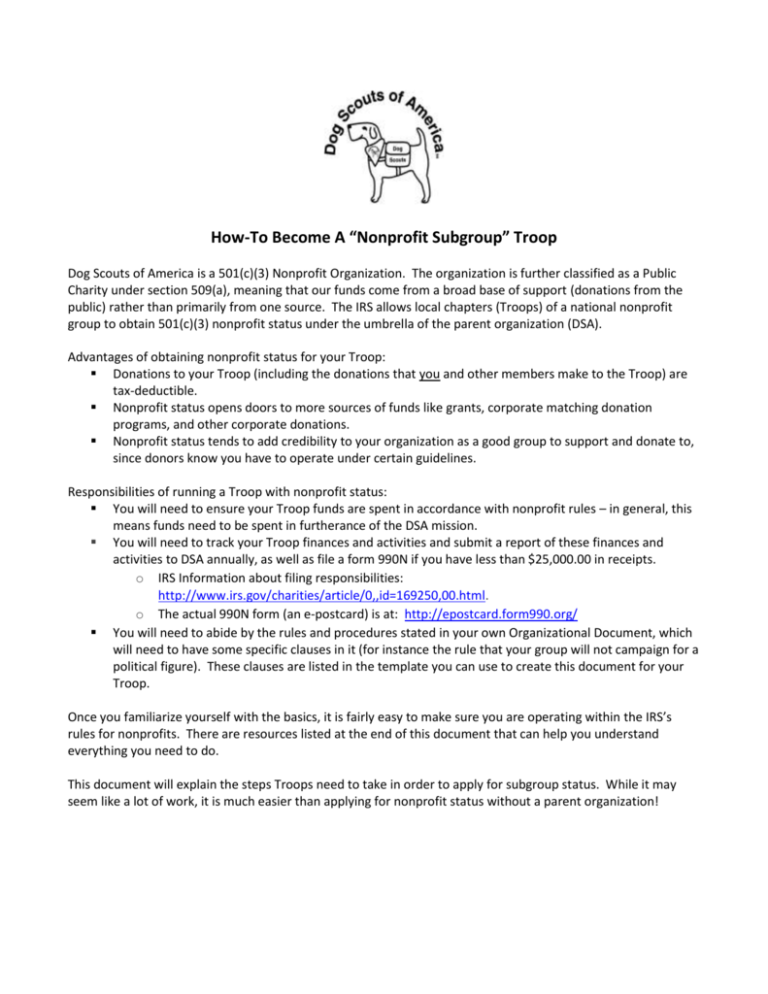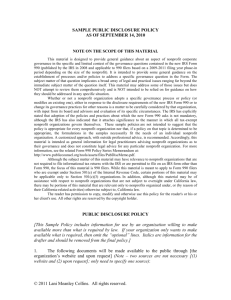Nonprofit Subgroup Status Explained
advertisement

How-To Become A “Nonprofit Subgroup” Troop Dog Scouts of America is a 501(c)(3) Nonprofit Organization. The organization is further classified as a Public Charity under section 509(a), meaning that our funds come from a broad base of support (donations from the public) rather than primarily from one source. The IRS allows local chapters (Troops) of a national nonprofit group to obtain 501(c)(3) nonprofit status under the umbrella of the parent organization (DSA). Advantages of obtaining nonprofit status for your Troop: Donations to your Troop (including the donations that you and other members make to the Troop) are tax-deductible. Nonprofit status opens doors to more sources of funds like grants, corporate matching donation programs, and other corporate donations. Nonprofit status tends to add credibility to your organization as a good group to support and donate to, since donors know you have to operate under certain guidelines. Responsibilities of running a Troop with nonprofit status: You will need to ensure your Troop funds are spent in accordance with nonprofit rules – in general, this means funds need to be spent in furtherance of the DSA mission. You will need to track your Troop finances and activities and submit a report of these finances and activities to DSA annually, as well as file a form 990N if you have less than $25,000.00 in receipts. o IRS Information about filing responsibilities: http://www.irs.gov/charities/article/0,,id=169250,00.html. o The actual 990N form (an e-postcard) is at: http://epostcard.form990.org/ You will need to abide by the rules and procedures stated in your own Organizational Document, which will need to have some specific clauses in it (for instance the rule that your group will not campaign for a political figure). These clauses are listed in the template you can use to create this document for your Troop. Once you familiarize yourself with the basics, it is fairly easy to make sure you are operating within the IRS’s rules for nonprofits. There are resources listed at the end of this document that can help you understand everything you need to do. This document will explain the steps Troops need to take in order to apply for subgroup status. While it may seem like a lot of work, it is much easier than applying for nonprofit status without a parent organization! How to Apply for Nonprofit Subgroup Status: 1. Let the parent organization know you would like to pursue nonprofit subgroup status. You will need to submit a letter in writing indicating your intent to be included in the Dog Scouts of America’s request for nonprofit subgroup status, which will be forwarded to the IRS with the rest of the required documents. This letter needs to be signed by at least one officer of the Troop. There is a template you can use to create this document. See the “Sample Authorization Letter” provided. 2. Get an Employer Identification Number (EIN) for your Troop. You can get this free online, file immediately, and get your number right away, at http://www.irs.gov/businesses/small/article/0,,id=102767,00.html , or you can mail in the completed form SS-4 www.irs.gov/pub/irs-pdf/fss4.pdf to the IRS. Instructions are at http://www.irs.gov/instructions/iss4/ch01.html. You will also be able to use this number to set up a bank account for your troop, and many banks will waive account fees for nonprofit groups. In the process, you will be registering the name of your group with the IRS, along with contact information (name, address, etc.) for a person that will be responsible for the organization, so that the government and/or banking organizations can track your activities for tax and other purposes. More info on EIN numbers: www.irs.gov/pub/irs-pdf/p1635.pdf (See the guide downloaded with these files or at the link on our website.) When you receive a letter (either online or in the mail, depending how you apply), you should keep this letter in a safe place and retain it for your records. Copies are useful. You will need to provide this EIN number with your submission. 3. Assign Troop Officers. Each Troop must have at least 2 Officers. These are leaders of the organization, and can be titles such as Troop Leader, Troop Co-Leader, Assistant Troop Leader, Secretary, Treasurer, etc. You will need to provide a list of these officers with each person’s full name, job within the troop / officer title, mailing address, and physical address. Include your Troop number and EIN on this document. 4. Create an Organizational Document. This document will spell out some basic operating procedures for your group, and it needs to basically match the Organizational Document of the parent organization (DSA). There are some specific clauses that need to be in your organizational document that have to do with managing the finances of your nonprofit group, such as what will happen to money raised for the nonprofit if the group ceases to exist. There is a template available for you to use. See the “Sample Organizational Document” included as a download with these files.) Keeping this document simple is encouraged, as the IRS has specific methods you need to follow in order to make changes to this document. It may be best to create a separate document if you would like to outline other basic procedures for your group. This document must show the date it was accepted by the organizations, and it must be signed by at least 2 Troop Officers. If you make any changes to your Organizational Document, you should create a separate list of amendments, which should also show the date each amendment was accepted by the group, and the list of amendments should also be signed by at least two Troop Officers. 5. Create a Detailed Listing of Activities. There is a template available for your use. See the “Sample Description of Activities” included as a download with these files. Most Troops can divide their activities into three general categories: Member Education, Public Education, and Community Service. For each activity, you must include: 1) What the activity is and/or how it is done, 2) When the activity is done (for instance, monthly or 3-6 times per year), 3) Where the activity is done, 4) By Whom, 5) How it furthers the organizational mission, and 6) Assign a percentage to each type of activity (and all of the listed activities must add up to 100%.) You can determine this percentage by looking back at past activities over a representative period of time, or if you are newly forming Troop you can make a tentative plan of activities and draw percentages from that plan. Remember that as a nonprofit organization, any purely social or “just for fun” activities should be incidental (meaning you spend a very small amount of money and time doing these things when compared to your Troop’s other activities.) However, most troop activities involve learning and enhance the human/canine bond, which does further the organization’s nonprofit mission, and can be classified in the Member Education category. 6. Pay IRS processing fees. The IRS charges a fee for processing nonprofit subgroup submissions, and Troops are expected to share a portion of this fee ($75). You send a check to DSA (payable to DSA). DSA has paid all fees for the troops’ privilege of having subgroup status in advance. 7. Forward the documents from steps 1, 3, 4, and 5, along with your processing fee to DSA. The IRS may take quite some time to respond to the request (expect several months), and when they do they may request further information, clarification, or changes to your documents for further review with a much shorter timeline for you to respond to them. The more organized and complete your documents are, the less likely it is the IRS will need a resubmission. The templates available for your use are intended to speed the process along, as well as to help ensure your documents meet the requirements of the IRS the first time. 8. See if your state has additional requirements. Check this website: http://www.multistatefiling.org/ to see if you are in a state that requires additional paperwork and fees to be on record as a public charity within your state. It has the instructions for filling out the URS (Unified Registration Statement) and any other required forms, and it has the list of states that require additional paperwork and additional fees to be submitted. 9. Begin Operating Under Nonprofit Guidelines. You should begin operating under nonprofit rules as soon as, if not before, you submit your request for nonprofit status. The IRS website www.irs.gov has lots of information of what you can and cannot do, what needs to be tracked for your group, etc. and some tips for managing nonprofit groups. There is also an IRS customer service phone line. You can also contact fellow Troop Leaders that operate nonprofit Troops. Templates Available From DSA for Your Use: You can use these templates to create the four documents you will need to include in your submission for nonprofit subgroup status: Authorization Letter of intention to be included as a nonprofit subgroup. Organizational Document Description of Troop Activities. Listing of Troop Officers (names, address, phone and email for the troop leader, and if applicable: coleader, treasurer, and secretary) (First three items have templates included for download in these files, as well as on the website.) Learning About Operating a Nonprofit Organization Operating as a nonprofit group has some responsibilities, and you should familiarize yourself with some of the basics to ensure that your group doesn’t inadvertently defraud the government! Don’t worry though, if you read through a few of the IRS’s short and easy-to-read brochures like P-3637 and P-4221, it will give you a good general idea of the basics of operating a nonprofit organization. DSA will file annual federal tax paperwork for the entire group, using information provided by you. Some of the other documents listed below are more extensive listings of rules and procedures and may be a good resource for any questions you might have. You can download the publications listed below from the IRS website: www.irs.gov. Helpful IRS Brochures and Guides: IRS Publication 3637 – Exempt Organizations Intro Brochure o This brochure has a nice listing of all of the helpful resources available IRS Publication 4221 – Compliance Guide for 501(c)(3) Public Charities o This 36-page brochure goes over activities that could jeopardize your nonprofit status, records that need to be kept, and other resources for assistance. IRS Publication 4573 – Group Exemptions o 4 pages explaining the basics of the nonprofit subgroup status program IRS Publication 557 – Tax Exempt Status for Your Organization o Extensive 72-page document explaining all about tax exempt organizations. o Pages 6-8 talk about group exemptions o Chapter 2 talks about reporting requirements (DSA will file reports on behalf of subgroups with information you provide) and disclosures (for instance dealing with very large donations). o Page 69 is a generic example of an Organizational Document IRS Publication 4220 – Applying for 501(c)(3) Tax-Exempt Status Brochure o Small easy-to-read brochure. Page 12 talks about operating your organization while your application is pending, and about accepting donations and filing reports during this time. o This brochure also goes over basics of eligibility and reporting responsibilities. IRS Publication 526 – Charitable Contributions o This publication goes over what kinds of contributions are tax-deductible, what kinds of donations you need a receipt for, etc. o As a nonprofit organization, you may get questions about contributions and be asked for receipts. You may also be contributing quite a bit to the organization yourself and may wish to consider itemizing these contributions on your own taxes. This publication can tell you more about both of these situations.







